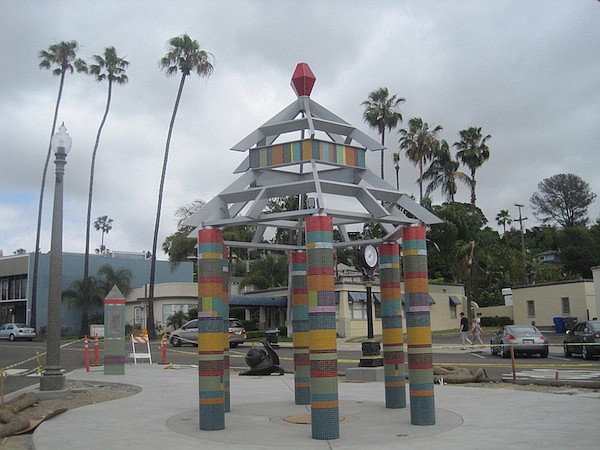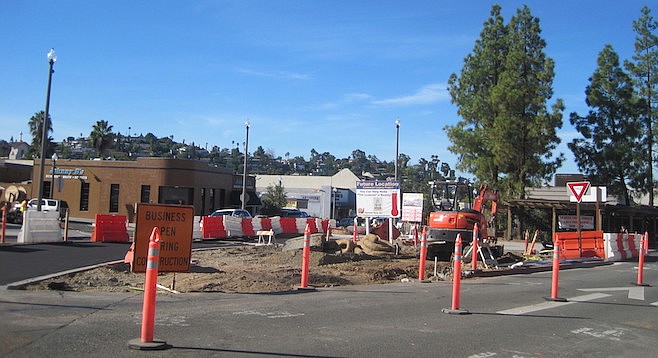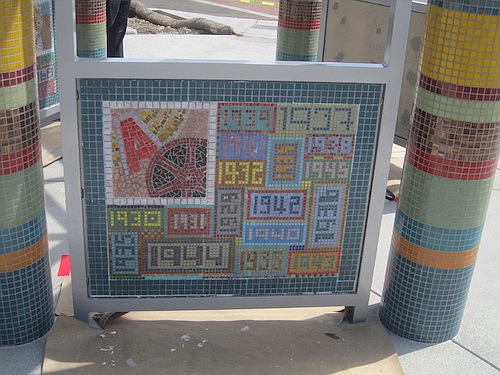 Facebook
Facebook
 X
X
 Instagram
Instagram
 TikTok
TikTok
 Youtube
Youtube

People passing by the intersection of La Mesa Boulevard and Allison Avenue have seen a former traffic island transformed into a triangle now named Legacy Park.

Eight mosaic-covered columns and a 450-pound bronze snail are in the pocket park that celebrates 100 years in the history of the city that incorporated in 1912. The pieces are part of The Lookout, a public art project created by La Mesa artists Jesus (Jesse to his friends) and Mary Lynn Dominguez, and their daughter, Amy Dominguez (a Santee resident). Other elements in the centennial piece include a roof that connects the columns into a six-sided gazebo. A red jewel on the roof symbolizes La Mesa’s motto, “Jewel of the Hills.”

That’s the scene I photographed on May 15. When I interviewed Jesse and Mary Lynn on May 20, four of six half-panels were installed, adding walls to the gazebo. Before the interview, assistant city manager Yvonne Garrett told me the project cost an estimated $165,000.
“Funding has come from community donations and the downtown streetscape project. We are still collecting donations for the project.”
Jesse and Mary Lynn met at the Otis Arts Institute (now the Otis College of Art and Design) in Los Angeles. He majored in sculpture; she majored in drawing. The Dominguezes moved to La Mesa in 1976 because of Jesse’s assignment to teach sculpture at San Diego State University.
The couple’s résumé of local public art includes Jesse’s life-size bronze sculpture of Alonzo Horton at Horton Plaza. Amy’s involvement in artwork started when she helped her mother with See Shells, mosaic pieces located on walls at the entrances to 12 restrooms in Terminal 2 at San Diego International Airport.
Collaboration on The Lookout involved brainstorming. Mary Lynn drew concepts on the computer and showed the results to her family. Jesse joked, “I’d tell them the right way [to do it], and Amy would say, ‘You’re going to do what?’” He added that Amy suggested calling the piece The Lookout because La Mesa Boulevard was originally Lookout Avenue.

Mary Lynn spoke about the design, saying gazebos were traditionally in the heart of a community. The family saw that the gazebo fit with the “small-town feeling” of La Mesa’s downtown Village.
She said the mosaic panel with wagon wheels depicts the city’s early history; another panel represents agriculture. Movie history is portrayed by a panel with the logo for the Flying A, the studio that filmed westerns in La Mesa from 1911–1912. Baseballs are a reminder that La Mesa North (now Fletcher Hills) won the Little League World Series in 1961.
Still to be installed on May 20 were a panel saluting the Flag Day parade and another one for Oktoberfest. Stained-glass panels below the roof will depict the sky and hills.
The snail is Felix the Helix, Jesse’s bronze piece commemorating Helix aspera. According to La Mesa history, scientist Louis Agassiz found and named the snails in 1872. He discovered the snails on land later named Mount Helix.
Jessie said that while it is safe for children to play on Felix, warm weather would heat the bronze piece. A three-sided column beyond the gazebo will display plaques with the names of those who contributed $500 or more, Garret said.
Also on the site is a street clock donated by the nonprofit La Mesa Beautiful and Jim Simpson (owner of Time and Treasures) as a memorial to his late son Ryan.
People who stopped by to talk to the Dominguezes included mayor Mark Arapostathis. He said he’s received “so many compliments about the project.” Remarks included, “It’s so great to see public art.” Fans include students at La Mesa Arts Academy, where the mayor is the theater arts director.
Garrett said plans are underway for a celebration toward the end of June. The date will be announced soon for the grand opening that will include the insertion of a time capsule in a concrete vault beneath the centennial logo. The capsule containing items “memorializing the [yearlong] centennial celebration and donor names will be opened in 2062 — the city’s 150th birthday.”


People passing by the intersection of La Mesa Boulevard and Allison Avenue have seen a former traffic island transformed into a triangle now named Legacy Park.

Eight mosaic-covered columns and a 450-pound bronze snail are in the pocket park that celebrates 100 years in the history of the city that incorporated in 1912. The pieces are part of The Lookout, a public art project created by La Mesa artists Jesus (Jesse to his friends) and Mary Lynn Dominguez, and their daughter, Amy Dominguez (a Santee resident). Other elements in the centennial piece include a roof that connects the columns into a six-sided gazebo. A red jewel on the roof symbolizes La Mesa’s motto, “Jewel of the Hills.”

That’s the scene I photographed on May 15. When I interviewed Jesse and Mary Lynn on May 20, four of six half-panels were installed, adding walls to the gazebo. Before the interview, assistant city manager Yvonne Garrett told me the project cost an estimated $165,000.
“Funding has come from community donations and the downtown streetscape project. We are still collecting donations for the project.”
Jesse and Mary Lynn met at the Otis Arts Institute (now the Otis College of Art and Design) in Los Angeles. He majored in sculpture; she majored in drawing. The Dominguezes moved to La Mesa in 1976 because of Jesse’s assignment to teach sculpture at San Diego State University.
The couple’s résumé of local public art includes Jesse’s life-size bronze sculpture of Alonzo Horton at Horton Plaza. Amy’s involvement in artwork started when she helped her mother with See Shells, mosaic pieces located on walls at the entrances to 12 restrooms in Terminal 2 at San Diego International Airport.
Collaboration on The Lookout involved brainstorming. Mary Lynn drew concepts on the computer and showed the results to her family. Jesse joked, “I’d tell them the right way [to do it], and Amy would say, ‘You’re going to do what?’” He added that Amy suggested calling the piece The Lookout because La Mesa Boulevard was originally Lookout Avenue.

Mary Lynn spoke about the design, saying gazebos were traditionally in the heart of a community. The family saw that the gazebo fit with the “small-town feeling” of La Mesa’s downtown Village.
She said the mosaic panel with wagon wheels depicts the city’s early history; another panel represents agriculture. Movie history is portrayed by a panel with the logo for the Flying A, the studio that filmed westerns in La Mesa from 1911–1912. Baseballs are a reminder that La Mesa North (now Fletcher Hills) won the Little League World Series in 1961.
Still to be installed on May 20 were a panel saluting the Flag Day parade and another one for Oktoberfest. Stained-glass panels below the roof will depict the sky and hills.
The snail is Felix the Helix, Jesse’s bronze piece commemorating Helix aspera. According to La Mesa history, scientist Louis Agassiz found and named the snails in 1872. He discovered the snails on land later named Mount Helix.
Jessie said that while it is safe for children to play on Felix, warm weather would heat the bronze piece. A three-sided column beyond the gazebo will display plaques with the names of those who contributed $500 or more, Garret said.
Also on the site is a street clock donated by the nonprofit La Mesa Beautiful and Jim Simpson (owner of Time and Treasures) as a memorial to his late son Ryan.
People who stopped by to talk to the Dominguezes included mayor Mark Arapostathis. He said he’s received “so many compliments about the project.” Remarks included, “It’s so great to see public art.” Fans include students at La Mesa Arts Academy, where the mayor is the theater arts director.
Garrett said plans are underway for a celebration toward the end of June. The date will be announced soon for the grand opening that will include the insertion of a time capsule in a concrete vault beneath the centennial logo. The capsule containing items “memorializing the [yearlong] centennial celebration and donor names will be opened in 2062 — the city’s 150th birthday.”
Comments